Smoky quick pickled red onions are loaded with flavor and ready in minutes!
Everyone loves these crisp, slightly sweet, and smoky red onions pickled in red wine vinegar and smoked sea salt brine.
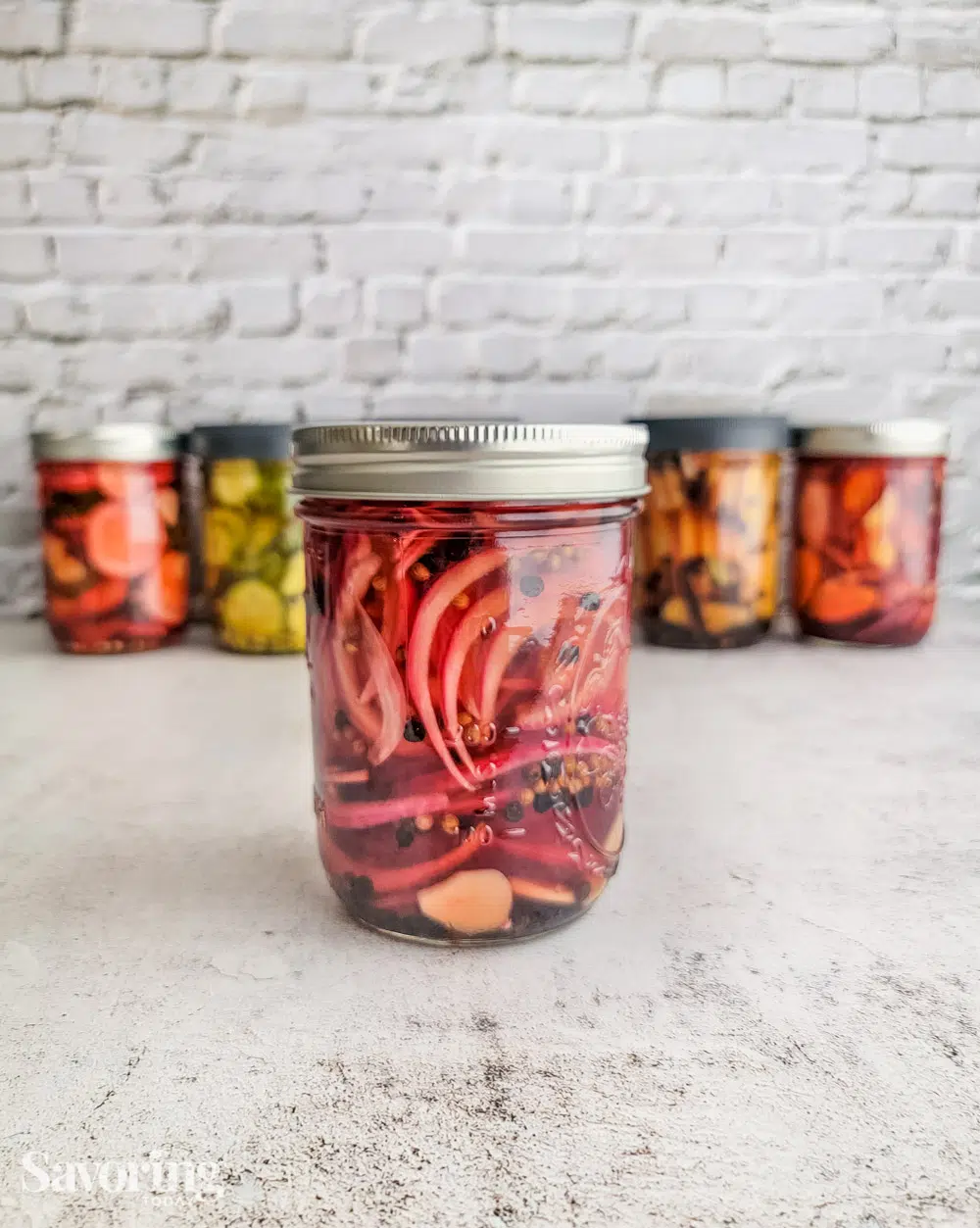
In this recipe for Smoky Pickled Red Onions, we are using the quick pickle method. That means you’ll have some amazing pickled onions to enjoy with only a few minutes of prep (though some patience is needed to let the flavors develop.)
As much as I love the sweet-savory punch of pickled red onions from the most basic brine, I couldn’t help but add a slight twist of smoky flavor with hickory-smoked sea salt.
It’s the same salt I use in our steak rub, which is amazing, so why not swirl it into our quick pickle brine?
In addition to the change-up in salt, we opt for red wine vinegar for the brine to bring in a deeper, dark fruit flavor that also pairs well with smokey things. It’s just so good!
The result is delicious, crisp, slightly sweet, and smokey red onions, pickled and ready in less than 24 hours. (Feel free to “test” them sooner to find the just-right taste for you!)
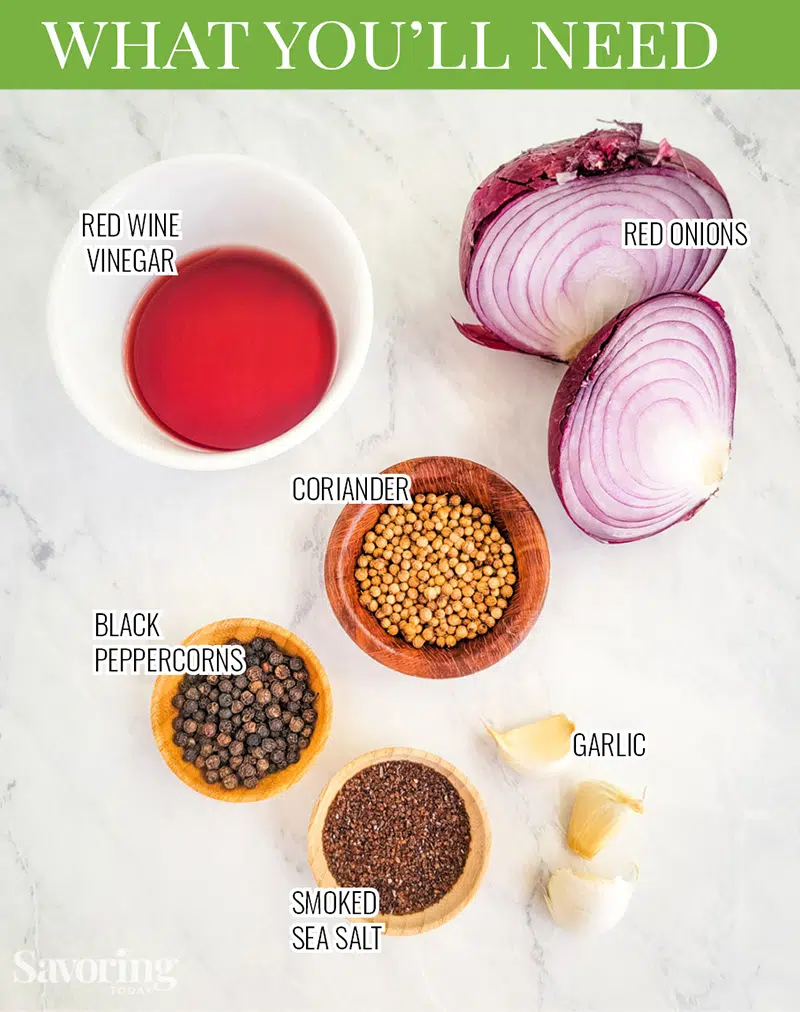
Four simple ingredients to pack the jars and six quick steps are all it takes! No special equipment is required, just grab 2 pint-size jars with tight-fitting lids and a saucepan to heat the brine.
Would you believe all you have to do is heat the vinegar, water, smoked salt, and sugar while stuffing the jars with coriander, peppercorns, garlic, and onions? Yep, that’s all there is to it!
Recipe Step by Step
- Simmer vinegar, water, sugar, and smoked sea salt in a saucepan to dissolve salt and sugar.
- Slice the garlic cloves and onions.
- Divide the peppercorns and coriander in the bottom of each jar.
- Layer the onions with the garlic into the jars on top of the spices.
- Pour enough hot brine into the jar to fully cover all ingredients—fill to just under the mouth of the jar. NOTE: If using weights, fill to 1-inch below the rim to leave room for the thickness of the weight.
- Cool to room temperature, screw on the lid, and keep refrigerated for up to 1 month.
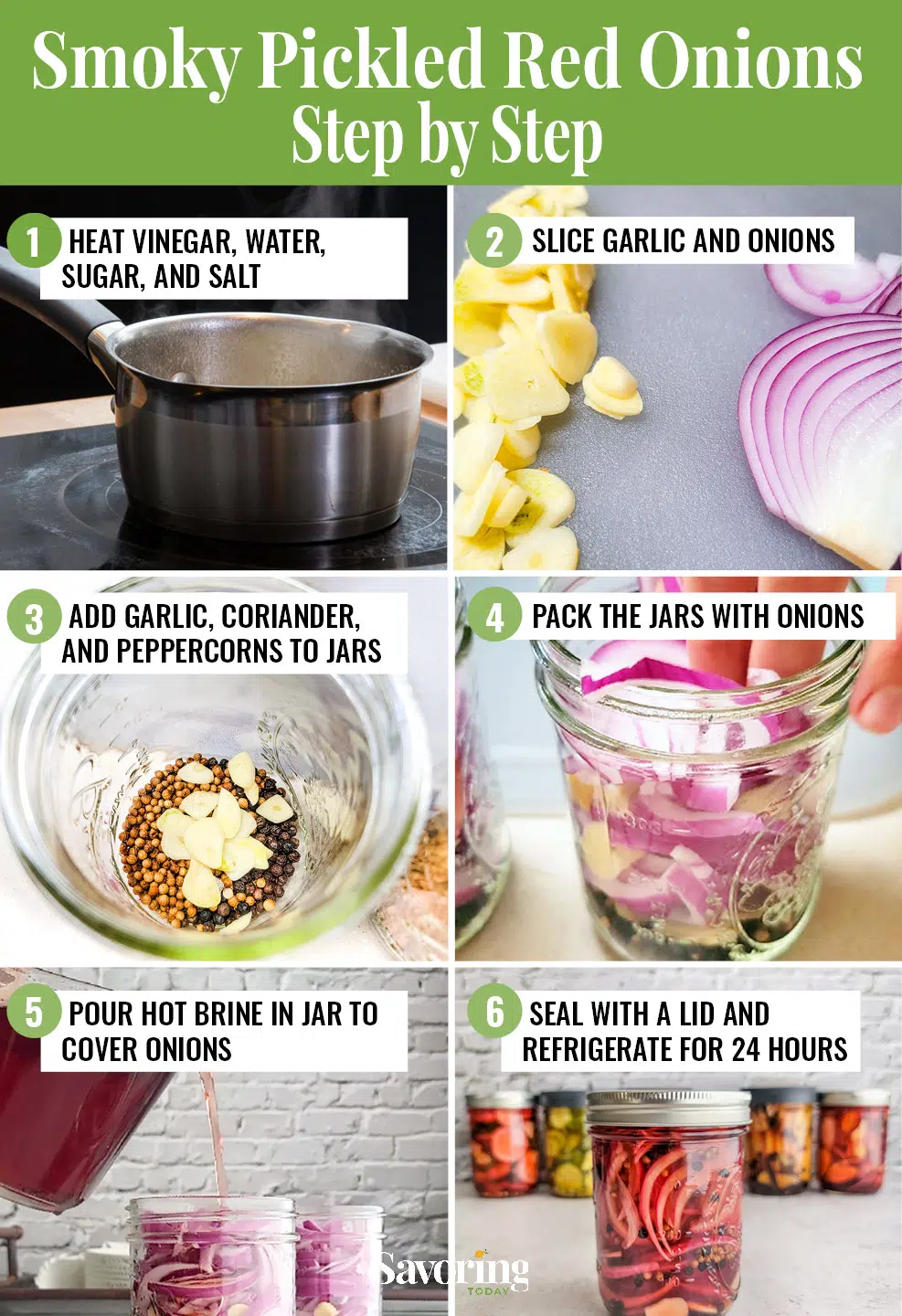
Pickle Primer
Pickles. Crunchy, salty, sweet, spicy, bright, acidic, tart, herbaceous, vegetal, vinegary pickles. An amazing food enjoyed straight from the jar, the champion of a classic burger, the just-right addition to a salad, charcuterie’s favored palate cleanser, and a superb balancing garnish.
Pickles span the spectrum of flavors both bold and nuanced, playing harmoniously within the characteristic vinegar base. It’s hard to say what the best part of pickles is—the irresistible crunch or the mouthwatering tart, sour flavors we know and love.
What is Pickling?
One of the oldest methods of food preservation, pickling has been around for well over 4000 years and remains prevalent across many cultures today. The United States leans heavily into dill pickles, Korea is known for its kimchi, and Germany for its sauerkraut. Aam ka achar hails from India, tsukemono is eaten regularly alongside Japanese cuisine, and even Sweden joins the table with its famous pickled herring.
The actual word comes from the Dutch word pekel or German word pókel, meaning “salt” or “brine”, which is a crucial element of pickle making.
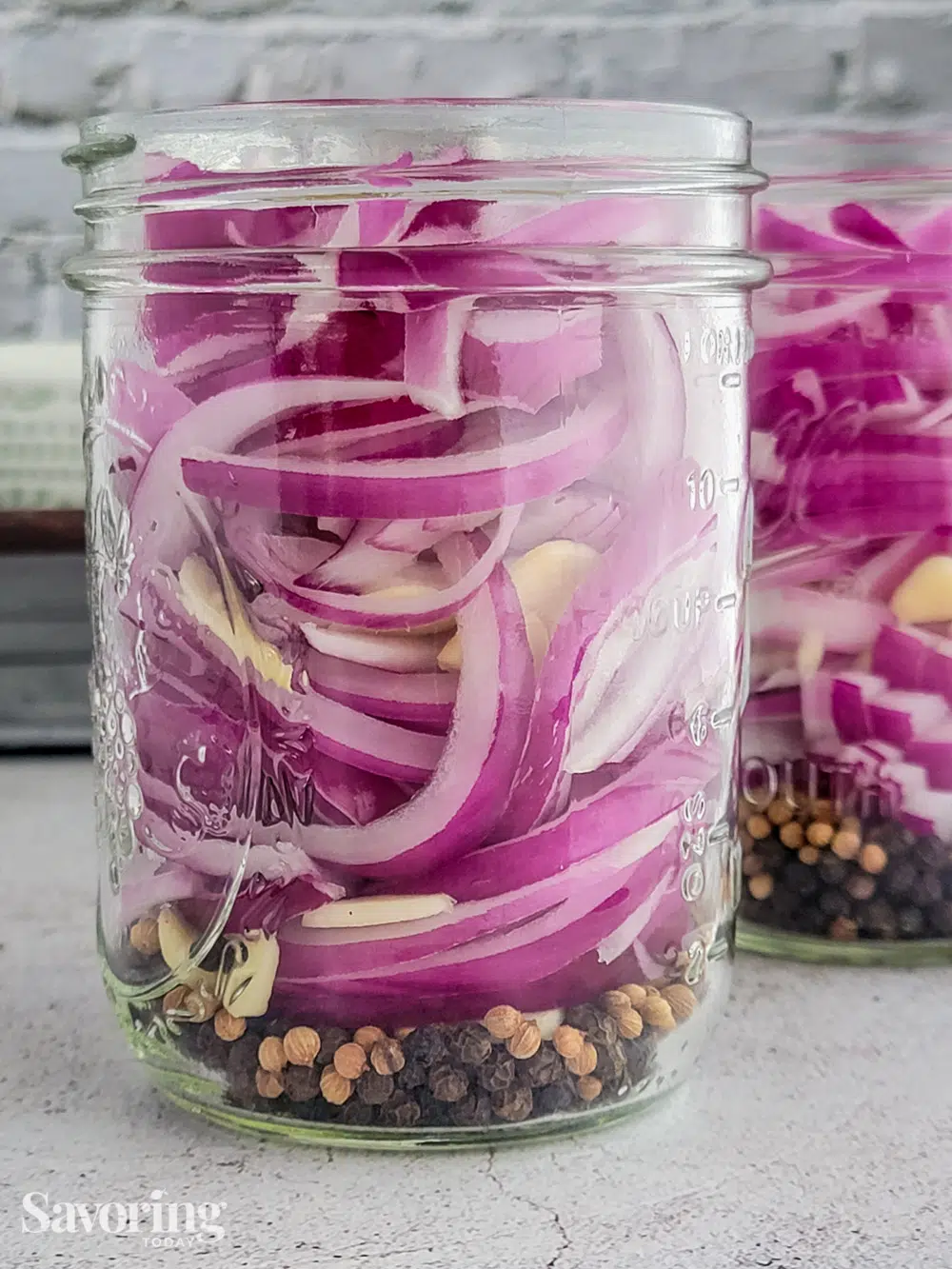
Types of Pickling
There are three primary methods for home pickling: Salt Brine, Vinegar Brine Soak & Rinse, and Quick Pickle, which is the method we are using in this recipe. Check out this handy Wisconsin Safe Food
Preservation Series for more pickle-perfect details.
Salt Brine (Lacto-Fermentation)
Salt is applied liberally and directly to the fresh produce to draw water out of the vegetables or fruits by way of osmosis. Later, it is rinsed and placed into a brine, and due to the salt treatment, has an increased capacity for taking in the brining liquid and acquiring deeper flavor. Salt brine is often a precursor to fermented pickles.
Fermentation is a process where food is transformed by bacteria (typically lactic acid) eating the sugars and carbohydrates within the pickled item, which then produces other substances like alcohol, carbon dioxide, or acid which act as natural food preservatives.
Examples include any and all alcohol, kombucha, sourdough bread, miso, and cultured yogurt. Many fermentations start with a brine too!
Fermentation extends the time the pickles can be stored in the refrigerator (4 to 6 months).
Vinegar Brine Soak & Rinse (Water Bath Canning)
It’s exactly what it sounds like, produce is soaked in the pickling liquid, drained, and soaked again, allowing for maximum saturation of the pickling liquid in the veggies and fruits used.
This process is used to develop deeper flavors and a crunchier pickle and is often the precursor to fermenting and water bath canning. The water bath process is more demanding but worth it if your goal is longer shelf life.
Quick Pickling (Refrigerator Pickles)
The method of choice in this recipe, quick pickling (also known as “refrigerator pickles”) is precisely that—the fastest way to make delicious pickles. Using sterilized jars and washed organic produce, a hot pickling brine is poured over fresh produce into a jar, allowed to cool completely, and then refrigerated.
Quick pickles are ready within 24 hours and are sometimes even ready within 1 or 2 hours. The smaller batch size is designed to match the rate at which you’d eat them.
Stored in tightly-sealed jars in the refrigerator, you can enjoy quick pickles for up to 1 month so long as you keep the contents below the brine.
What’s in the Quick Brine?
The brine for quick pickles is made up of vinegar with salt, sugar, water, and sometimes lemon, infuses with the vegetables or fruits, imparting that beloved sour flavor. It often includes spices and herbs to impart additional flavors for a broad range of inspired creations.
Why Add Salt?
The presence of salt in fermentation is imperative because salt has antimicrobial properties that keep bad bacteria at bay, a job it has held for centuries. However, with quick pickling, the salt is used to enhance and balance flavor.
PRO TIP: Use empty tea bags for your spices if straining them out is annoying.
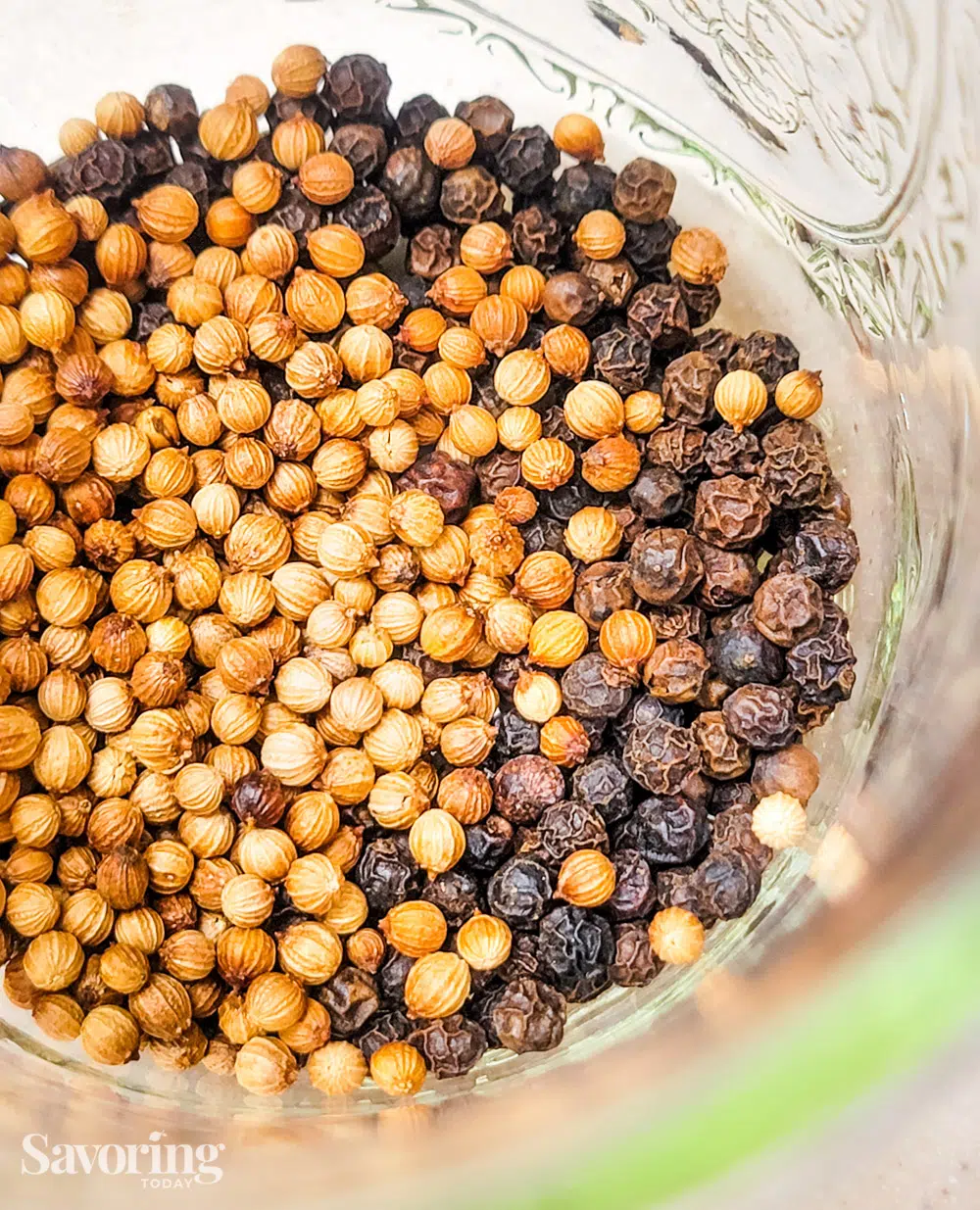
What kinds of things can I use to flavor the brine?
The results are wildly different, one touting a more herbaceous and savory flavor, while the other expresses baking spice sweetness and a hint of black licorice. I recommend experimenting since it’s pretty low risk to make quick pickles, and the combinations are endless.
It is a good practice to keep it simple and choose 2-4 maybe 5 things to influence your brine.
Consider the flavor profile of the items you’re pickling and choose your spices according to what pairs best with that item’s flavor.
For instance, a classic combination in standard kosher pickles is dill, mustard seed, celery seed, and red pepper flakes. If you chose to pickle an apple, however, you may choose star anise, cardamom, vanilla, and black pepper.
NOTE: One of my favorite books to reference for ideas in almost every recipe is The Flavor Bible. This book contains a list of nearly every viable ingredient on the market and gives you other complimentary flavors to pair with it. Incredibly helpful for switching up ingredients to rejuvenate an old recipe and especially useful when choosing pickling spices.
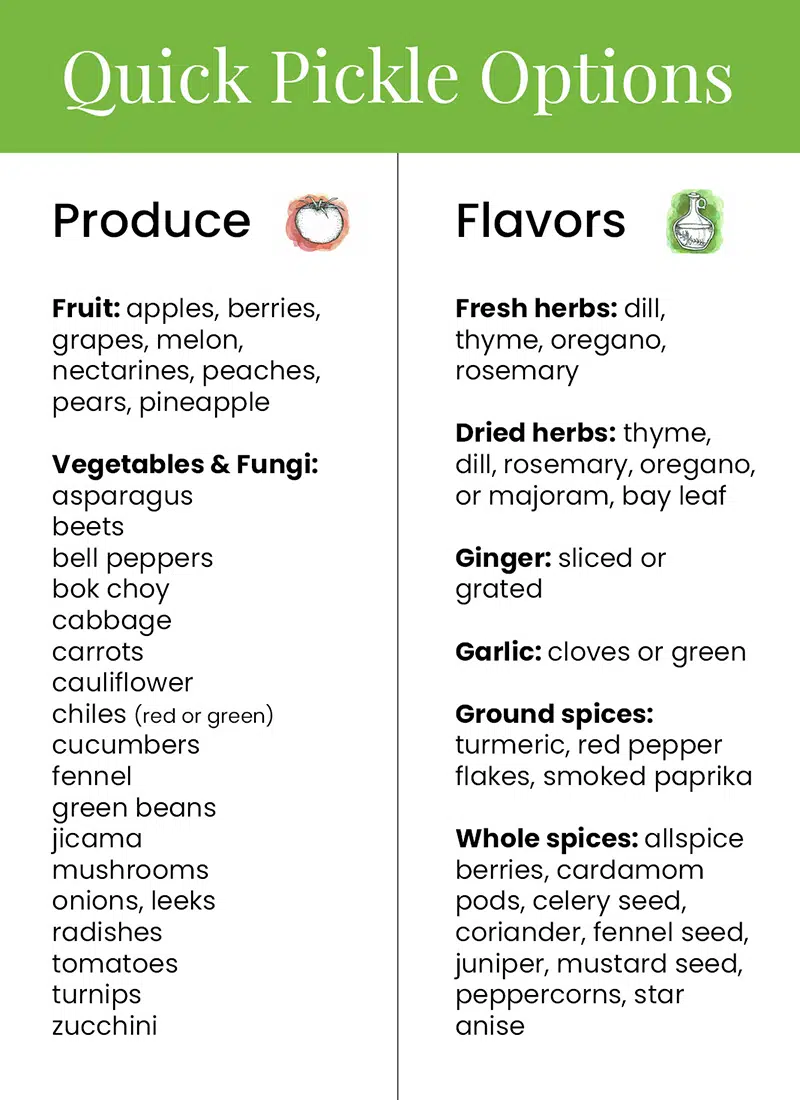
What kind of vinegar should I use?
Apple cider vinegar and distilled white vinegar are the most common choices for pickling. They sit at about 5% acetic acid (you can find this on the label) and are diluted to a 1:1 ratio with water in many recipes for pickle brine.
I prefer apple cider vinegar in my pickling recipes because its flavor is more mellow and natural. It does impart a slightly yellow color to the pickle brine, so if the color of the brine is very important to you stick with white vinegar.
Red wine, white wine, sherry, and champagne vinegar are great additions. I use them as a split base with white or ACV to impart some flavor but not as the only vinegar.
In this recipe for pickled red onions, the red wine vinegar brings on a deeper flavor and a hint of dark red fruit, but no sweetness.
I don’t recommend using balsamic vinegar because of the cost and stronger flavor (it may be the only thing you taste). However, if you want to add a small amount to the other kinds of vinegar to experiment with, do what you feel.
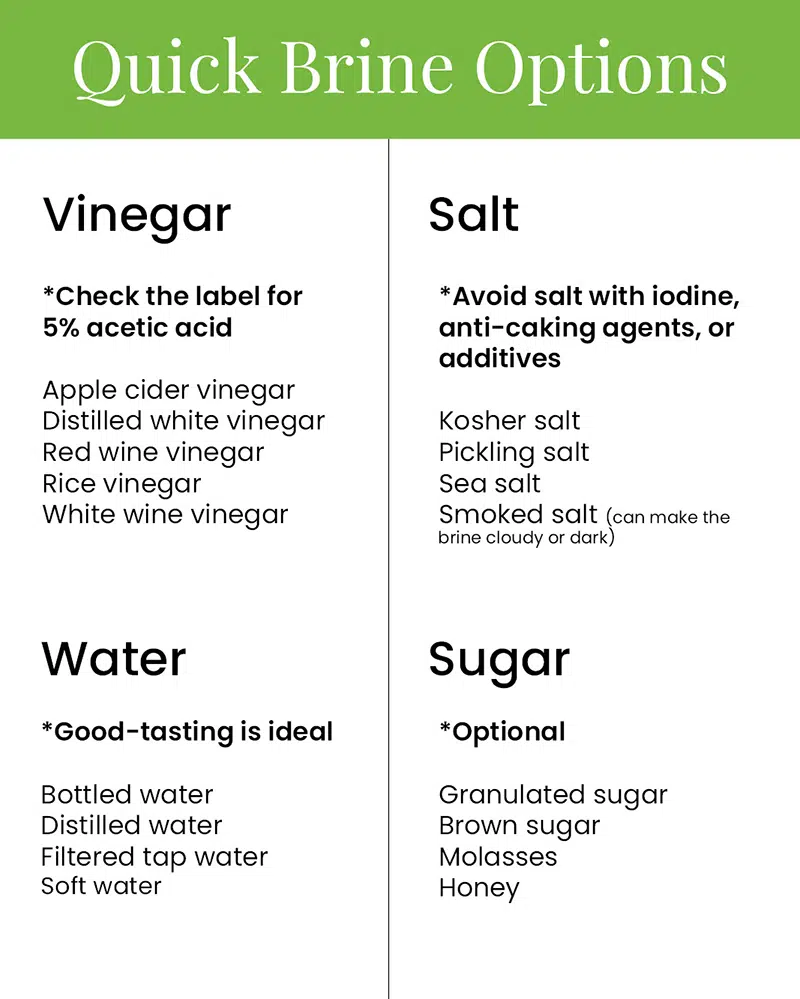
What kind of salt should I use?
We use kosher salt most often for our pickle brines. In this recipe, we use smoked sea salt to infuse a subtle smoky flavor, but you can use kosher salt and add a splash of liquid smoke instead.
There are some sources that recommend using unrefined sea salt or pickling salt to keep pickles crisp. The calcium and magnesium content in these salts encourage the pectin in vegetable cell walls to stay firm.
For a quick pickle, I am not concerned with crispness because the process and storing time is such a short turnaround that mushy veggies aren’t a concern. Choose your own path but don’t overthink it.
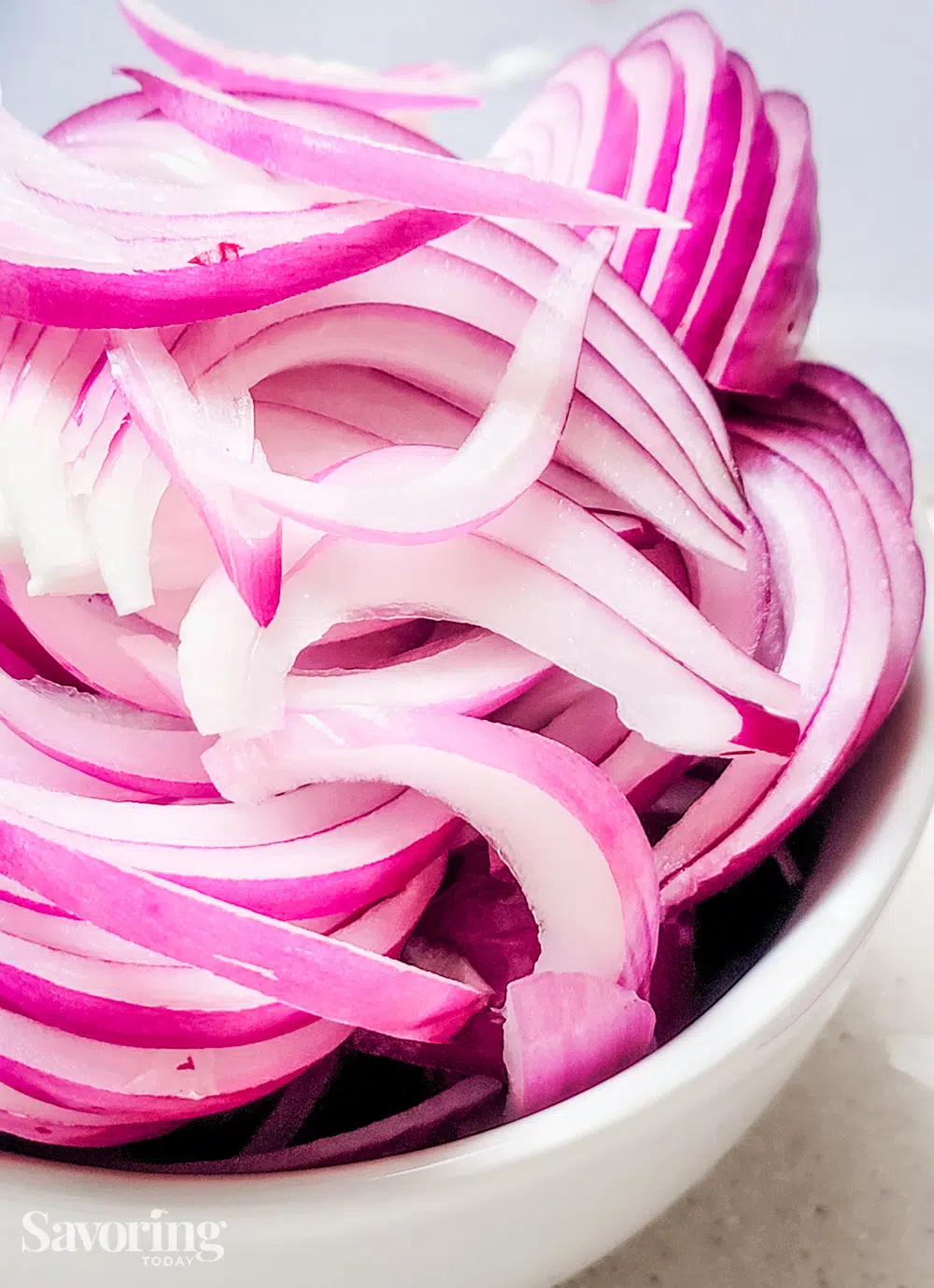
How do I cut the produce up?
It depends on what you’re trying to make and what you want to do with them. If you’re trying to eat pickles for a snack or pack them in a lunch, use larger pieces or wedges.
For instance, cucumbers and other long, circular produce can be quartered for spears or cut into thin chips. I’d likely do the spears or even whole if I want to enjoy them by themselves. Chips or extreme bias slices are nice for sandwiches and garnish.
Smaller pieces equate to more surface area which means bigger flavor, so thin slices or chips maximize the number of pickles in the jar and are simple to chop up for garnishes.
The best way to slice red onions for pickling:
How thinly the onions are sliced makes a difference in the texture of the finished pickle. If you prefer a softer texture, slice paper-thin across the center of the onion. For a firmer texture, slice the onion pole-to-pole about ⅛-inch thick.
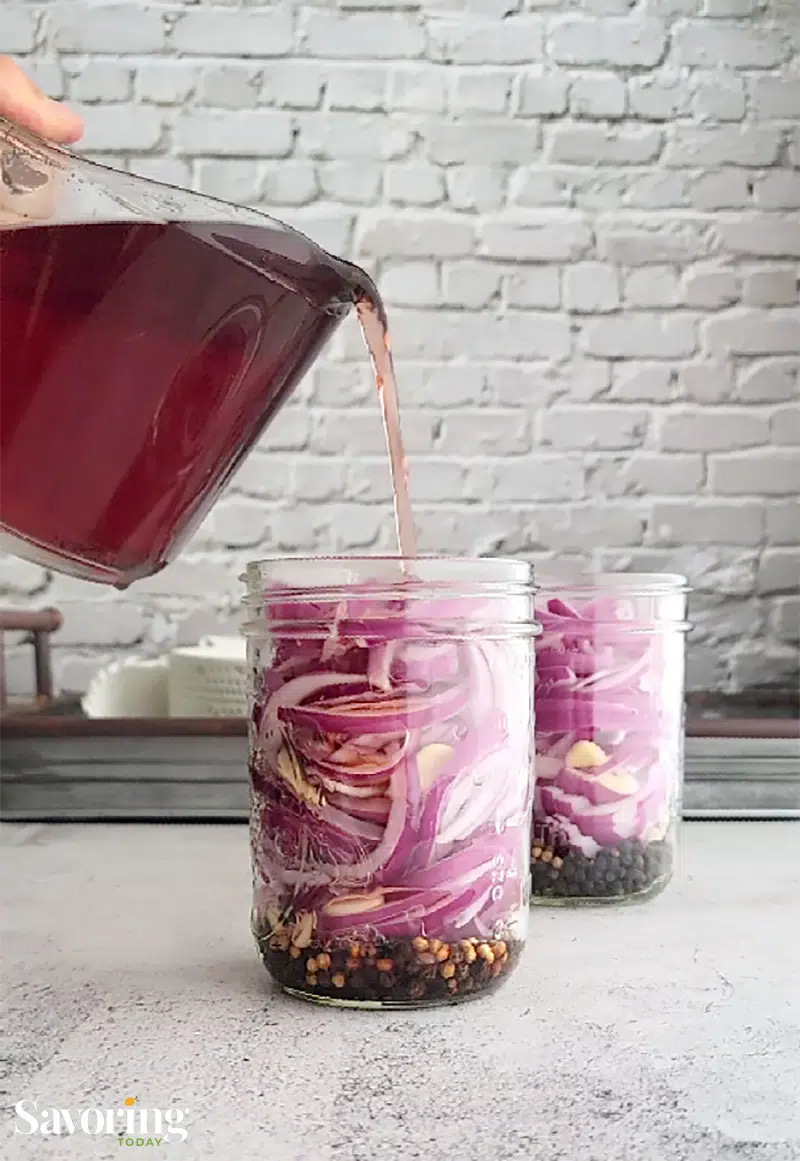
Quick Pickles FAQ
What can I quick pickle?
Aside from the obvious cucumber, any vegetable that you enjoy eating raw can be pickled, but the comprehensive list is very long and includes much more than just fruits and vegetables!
Pickled vegetables are a clear default, but did you know fruit is a great option for pickling because the sweetness of the fruit balances beautifully with the salt and sour of the brine? Don’t be shy, combine the produce and flavors you enjoy most!
♥ Check out our graphic above to see our list of favorite pickling vegetables and fruits.
PRO TIP: Avoid produce that has been coated in wax, treated with pesticides, or irradiated. Organic produce, as fresh as possible, is ideal.
How long will quick pickles last?
Quick pickles can last up to 1 month in the refrigerator, although it’s rare for pickled onions to hang around that long. They get demolished at our house.
NOTE: Always check for mold growth before consuming quick pickles and discard the entire contents of the jar if mold is present.
Do I have to heat the brine?
Yes, adding the pickling liquid while it is still nearly boiling causes the vegetable cell walls to open up which lets the pickling liquid penetrate more efficiently.
This encourages maximum flavor absorption in quick pickles because they will spend less time in the jar and are not fermented. The hot temperature also acts as low-level pasteurization, killing bacteria.
This post may contain affiliate links. See our disclosure policy for more information.
Do the vegetables have to stay below the brine?
Yes, the vegetables should stay below the brine to maintain freshness and retard mold growth. Some vegetables do this easily because they are less porous and don’t float. But for vegetables that tend to float, I use fermentation weights made from glass for use in wide-mouth pint jars.
Pickle weights are inexpensive and simple to use as the weight sits right on top of the vegetables to keep them under the brine. These pickle weights have a small inset knob to make it easy to remove from the jar to use the contents.
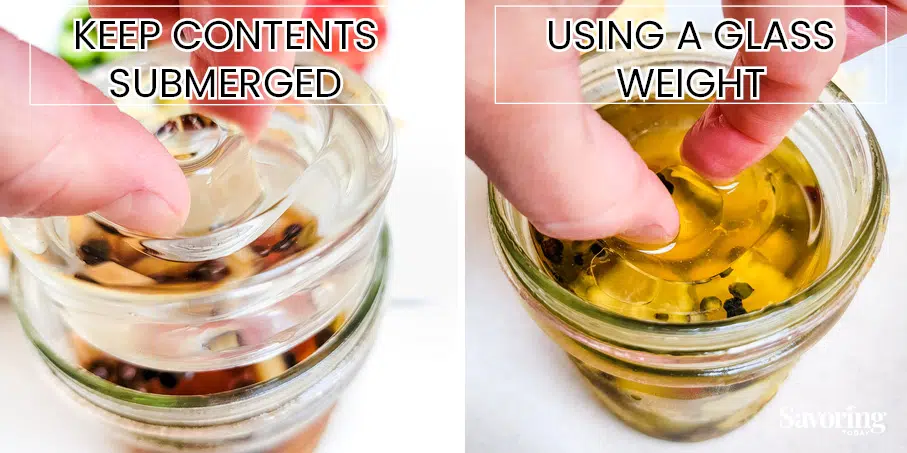
Can pickling liquid be reused?
Yes! Quick pickle brine or canned pickle brine can be reused for a quick pickle. Once I’ve eaten my first round of quick pickles I may cut up another similar item (something to match the flavor profile of the brine), such as a cucumber or onion.
Super-fresh produce is best, but you can use up slightly wilted (not moldy) veggies too. You are essentially marinading the produce and extending life by limiting exposure to air and slowing the breakdown process in the cooler refrigerator temperature.
The best practice is to consume this 2nd batch (in the reused brine) within the same 1 month time frame of the original pickle.
PRO TIP: Used quick pickle brine cannot be used for preserved (canning) pickles.
Use pickle brine in all kinds of recipes!
The acidic properties of pickle brine go well with all kinds of food. We love making deviled eggs adding a splash of pickle brine.
It can go into all kinds of picnic salads including pasta, tuna, and potato salad. Use it in a salad dressing or sauce that calls for vinegar, and of course, you can always add pickle brine to a bloody mary.
18 Ways to Serve Smoky Pickled Red Onions
- Pulled Pork Sandwiches
- Fish Tacos
- Nachos
- Fajitas
- Burrito bowls
- Burgers, Brats, & Hotdogs
- Chicken Salad
- Grilled Potato Salad
- Soups
- Salads
- Bagels with lox
- Scrambled eggs
- Avocado toast
- Grilled cheese
- Quesadillas
- Bruschetta
- Charcuterie board
- Deviled eggs
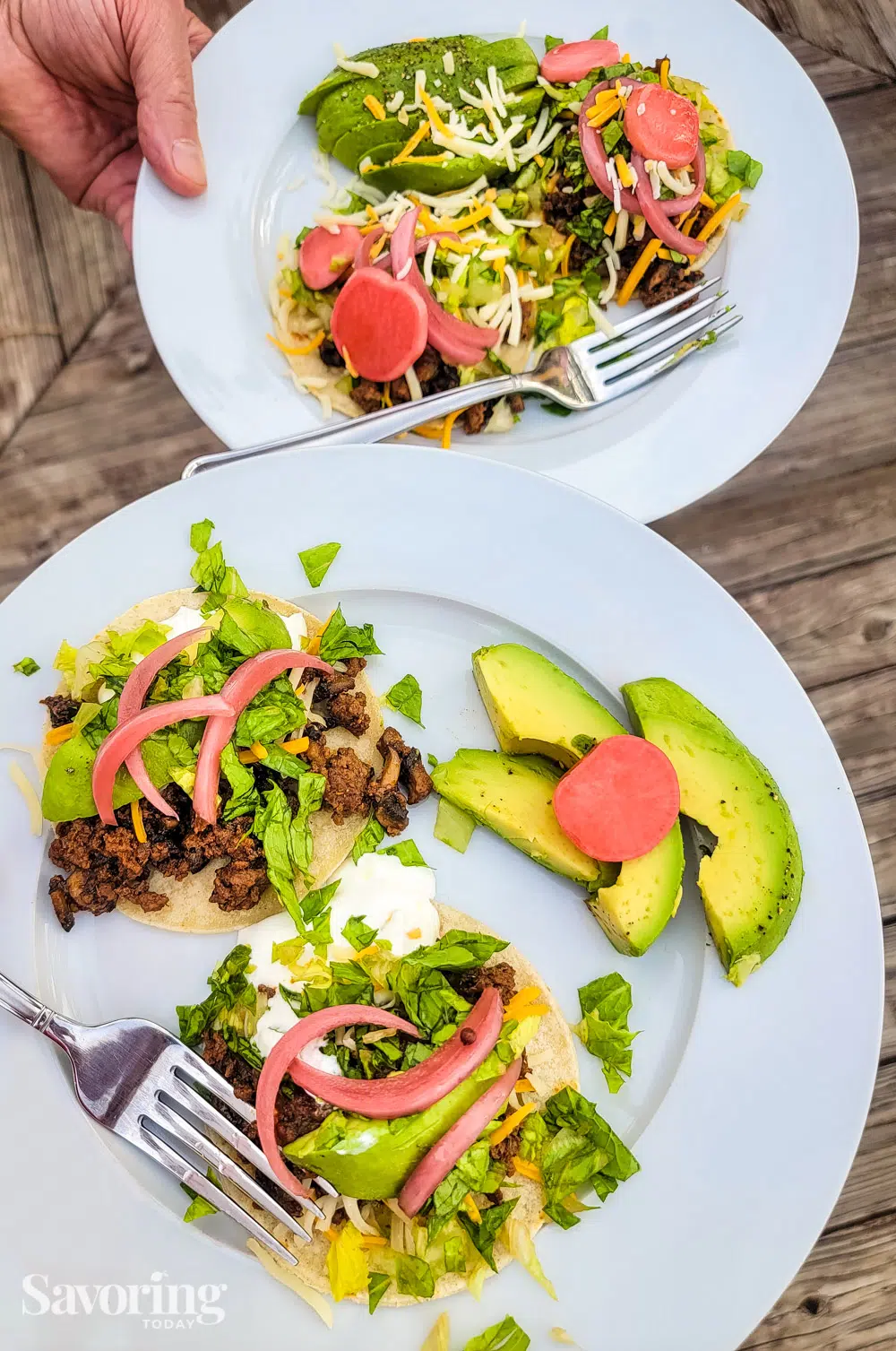
Smoky Pickled Red Onions
Ingredients
For the Brine
- 1 cup red wine vinegar
- 1 cup water
- 3 tablespoons sugar
- 1 tablespoon hickory smoked sea salt or other favorite flavor
For the Pickling Ingredients
- 2 medium medium red onions , sliced thin, pole to pole
- 4 cloves garlic , sliced
- 2 tablespoon black peppercorns
- 2 tablespoon coriander seeds
Instructions
- For the Brine: Add vinegar, water, sugar, and smoked sea salt to a saucepan and bring to a simmer over medium heat to dissolve salt and sugar. TIP: Do not leave at a simmer as you don't want to reduce the liquid.
- While waiting for the brine to heat up, thinly slice the garlic cloves and onions. If you prefer a softer texture, slice paper-thin across the center of the onion. For a firmer texture, slice the onion pole-to-pole about ⅛-inch thick.
- Divide the peppercorns and coriander in the bottom of each jar. Layer the onions with the garlic into the jars on top of the spices.
- Pour enough hot brine into the jar to fully cover all ingredients—fill to just under the mouth of the jar. NOTE: If using weights, fill to 1-inch below the rim to leave room for the thickness of the weight.
- Allow to cool to room temperature, screw on the lid, and refrigerate for up to 1 month.
Video Displays Here or In Post
Notes
- Quick pickles are ready when cooled, but best after 24 hours in the refrigerator.
- Quick pickles last up to 1 month in the refrigerator in a tightly sealed jar with the contents always submerged below the brine.
- Check out our quick pickle options graphics in the post to see our list of favorite pickling brines, vegetables, and fruits.
- Avoid produce that has been coated in wax, treated with pesticides, or irradiated. Organic produce, as fresh as possible, is ideal.
- Use quick pickle brine in place of vinegar in salad dressings.
- For more smoke flavor, add 2 teaspoons of hickory liquid smoke flavor to the brine.
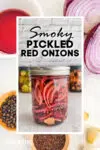

mjskitchen says
I use pickled red onions on tacos, sandwiches and rice bowl quite a lot. Love the other suggestions you provided. Also love this recipe. Very different from mine, but has more depth with the peppercorns, corianders and garlic. I’ll be trying this soon. Thanks Judy for sharing this!
Judy Purcell says
Thanks, MJ! Quick pickles on a rice bowl would be great too! There are so many combos to try and every one delicious.
John / Kitchen Riffs says
I love pickled onions. Just made a batch recently. 🙂 I do have some hickory smoked salt on hand, so next time I make pickled onions I need to use it. Nice recipe — thanks.
Judy Purcell says
Let me know how it goes, John!